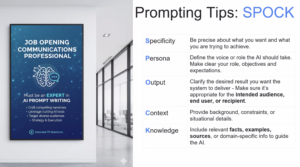Communicators can no longer rely on a one-tool approach to AI.
That was the message underscored by Ray Day, APR, as he opened the Nov. 10 Member Mondays session.
“AI is bigger than ChatGPT,” said Day, PRSA’s 2025 chair and Stagwell vice chair, and Allison Worldwide executive chair.
He assembled a panel of AI experts to demonstrate how various tools excel in different tasks. The session also coincided with the release of PRSA’s “AI Prompting 101: A ‘Start Here’ Guide for Professional Communicators.”

A multi-tool approach to AI
“There is a lot of conversation right now about which AI tool is the best one to use,” said panelist Marcel Goldstein, managing director of corporate affairs at Allison Worldwide. “But in reality, each AI tool has its strengths, weaknesses and quirks. None of them is best for everything. I like to think of AI chatbots like a member of my team. Each one has a specialty. Ask yourself: ‘Which AI tool works best for this particular job?’”
For gathering news and information, spotting trends or analyzing sentiment in real time, “Hands down, we have found Grok to be the best AI tool,” Goldstein said.
The panelists provided live demonstrations of how various AI tools can be utilized to complete specific communication tasks. Goldstein shared his screen so the audience could see the prompt he was entering into Grok. He asked the tool to find out what Fortune 500 CEOs were saying during the previous 24 hours, “by combing through news, press releases, interviews, social [media] commentary,” and so on.
In 50 seconds, Grok “gave me a nice, 150-word summary like I’d asked, with five CEO quotes from the last 24 hours, followed by a little sentiment breakdown in terms of positive, neutral, negative,” Goldstein said.
Where ChatGPT “really shines,” he said, is at “ingesting large volumes of information and then providing back brief, snapshot summaries.”
AI that ‘thinks and acts like a senior PR strategist’
Panelist Jaime Tero, managing director of Allison Worldwide, said Claude AI has a “propensity to think and interact like a senior PR strategist” and can quickly build a messaging framework. Claude AI “does a great job at interpreting nuances, it understands contexts deeply,” and can “write in natural, human business language,” Tero said.
Google’s Gemini AI is for research and analysis, while Microsoft Copilot is akin to “a secure vault for your internal data,” she said.
Tero also cautioned that when using AI, “you need to do quality control.” That might mean asking one AI program to verify the output that another AI tool has given you. “These AI models are starting points; they are not final sources,” she said. “Accuracy is really, really critical.”
PR professionals “have to remember that these AI tools don’t replace us,” Tero said. “They are [intended] to handle some of the admin work, to help scale and accelerate our efforts. You need to be that great PR professional that we all are.”
Prompting as a collaborative practice
Panelist Stephanie Parrott, marketing analytics and insights manager with Google DeepMind, advised that when prompting AI, communicators should start with a real problem and then engage in a dialogue with the tool, rather than making a demand. Remember that “AI is a collaborator, not a vending machine,” Parrott said.
“The magic of prompting is in the refinement,” she said.
Parrott offered these tips for getting started with prompts:
• Start with a real problem.
• Be patient — think dialogue, not demand.
• Master the art of the prompt — learn by asking Al itself.
• Be curious and experiment.
• Always have Al (and your prompt library) open.
She also shared prompting tips based on the SPOCK approach:

A prompting framework for PR pros
Panelist Amanda Carl-Pratt, head of communications at Google DeepMind, announced PRSA’s new “Prompting 101” introduction for professional communicators during the session.
She noted that the guide was built by communications professionals (Carl-Pratt, Parrott and Adam Pratt) and is available at this link. The resource includes prompts spanning message development, strategic planning, media relations, crisis communications, executive and internal communications, and social media.
Adam Pratt, director of issues and government communications at IBM, added that the sample prompts in the guide follow the SPOCK framework Parrott outlined earlier, encouraging communicators to refine their prompts for specificity, persona, output, context and knowledge.
No prompt is perfect, he said, and communicators should “be your own harshest critic” by giving AI systems feedback, iterating, and ensuring outputs clearly align with audience needs.
Pratt also underscored the importance of information hygiene when using AI tools. Before applying prompts to sensitive scenarios, especially in crisis communications, practitioners should follow their organization’s information security policies and avoid entering confidential or proprietary content into public AI systems.
He closed by emphasizing that the prompt library is a starting point. Communicators should feel free to copy, customize and expand it to suit their own workflows and team needs.
For all the practical guidance and live demos, watch the replay from Nov. 10 below:
After the session, Parrott shared her favorite AI-related newsletters, full of insights and practical guidance, for comms pros to explore:
• The Rundown AI
• TLDR AI
• The Neuron
• Superhuman AI
• 8020AI
Held on the second Monday of every month, the information-sharing Member Mondays are open to both PRSA members and nonmembers, focusing on topics of interest to the communications profession. Find more information here.
Photo credit: dc studio












![How Search Engines Work [Explained]](https://mgrowtech.com/wp-content/uploads/2025/08/how-search-engines-work-sm-350x250.png)



